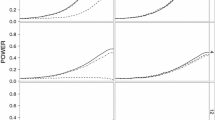Abstract
In this paper, we propose a new bootstrap algorithm to obtain prediction intervals for generalized autoregressive conditionally heteroscedastic (GARCH(1,1)) process which can be applied to construct prediction intervals for future returns and volatilities. The advantages of the proposed method are twofold: it (a) often exhibits improved performance and (b) is computationally more efficient compared to other available resampling methods. The superiority of this method over the other resampling method-based prediction intervals is explained with Spearman’s rank correlation coefficient. The finite sample properties of the proposed method are also illustrated by an extensive simulation study and a real-world example.
Similar content being viewed by others
References
Andersen, T.G. and Bollerslev, T. (1998). Answering the skeptics: yes, standard volatility models do provide accurate forecasts. Int. Econ. Rev. 39, 885–905.
Andersen, T.G., Bollerslev, T., Diebold, F.X. and Labys, P. (2001). The distribution of realized exchange rate volatility. J. Amer. Stat. Assoc. 96, 42–55.
Athreya, K. and Lahiri, S. 1994. Measure theory and probability theory. Springer.
Baillie, R.T. and Bollerslev, T. (1992). Prediction in dynamic models with time-dependent conditional variances. J. Econ. 52, 91–113.
Beyaztas, B., Firuzan, E. and Beyaztas, U. 2016. New block bootstrap methods: Sufficient and/or ordered. Communications in Statistics - Simulation and Computation. doi:10.1080/03610918.2015.1066808.
Bilingsley, P. 1994. Probability and measure, 3rd ed. Wiley.
Bollerslev, T. (1986). Generalized autoregressive conditional heteroskedasticity. J. Econ. 31, 307–327.
Carlstein, E. (1986). The use of subseries values for estimating the variance of a general statistic from a stationary sequence. Ann. Stat. 14, 1171–1179.
Chen, B., Gel Y.R., Balakrishna, N. and Abraham, B. (2011). Computationally efficient bootstrap prediction intervals for returns and volatilities in arch and garch processes. J. Forecast. 30, 51–71.
Efron, B. (1979). Bootstrap methods: another look at the jackknife. Ann. Stat. 7, 1–26.
Engle, R.F. and Patton, A.J. (2001). What good is a volatility model. Quant. Fin. 1, 237–245.
Giorgino, T. (2009). Computing and visualizing dynamic time warping alignments in r: the dtw package. J. Stat. Softw. 31, 1–24.
Hall, P. (1985). Resampling a coverage pattern. Stoch. Process. Appl. 20, 231–246.
Hall, P. 1992. The Bootstrap and Edgeworth Expansion. Springer.
Hall, P., Horowitz, J.L. and Jing, B. (1995). On blocking rules for the bootstrap with dependent data. Biometrika 82, 561–574.
Hannan, E.J. and Rissanen, J. (1982). Recursive estimation of mixed autoregressive-moving average order. Biometrika 69, 81–94.
Hansen, P.R. and Lunde, A. (2005). A forecast comparison of volatility models: does anything beat a garch(1,1)? J. Appl. Econ. 20, 873–889.
Hwang, E. and Shin, D.W. (2013). Stationary bootstrap prediction intervals for garch (p, q). Commun. Stat. Appl. Methods 20, 41–52.
Kunsch, H.R. (1989). The jackknife and the bootstrap for general stationary observations. Ann. Stat. 17, 1217–1241.
Lahiri, S.N. 2003. Resampling methods for dependent data. Springer.
Miguel, J.A. and Olave, P. (1999). Bootstrapping forecast intervals in arch models. Test 8, 345–364.
Nelson, D.B. (1990). Stationarity and persistence in the garch(1,1) model. Econ. Theory 6, 318–334.
Pascual, L., Romo, J. and Ruiz, E. (2006). Bootstrap prediction for returns and volatilities in garch models. Comput. Stat. Data Anal. 50, 2293–2312.
Politis, D.N. and Romano, J.P. (1992). A circular block-resampling procedure for stationary data. Explor. Limits Bootstrap 263–270.
Politis, D.N. and Romano, J.P. (1994). The stationary bootstrap. J. Am. Stat. Assoc. 89, 1303–1313.
Ratanamahatana, C.A. and Keogh, E. 2004. Everything you know about dynamic time warping is wrong. Third Workshop on Mining Temporal and Sequential Data.
Reeves, J.J. (2005). Bootstrap prediction intervals for arch models. Int. J. Forecast. 21, 237–248.
Thombs, L.A. and Schucany, W.R. (1990). Bootstrap prediction intervals for autoregression. J. Am. Stat. Assoc. 85, 486–492.
Acknowledgements
We thank two anonymous referees for careful reading of the paper and valuable suggestions and comments, which have helped us produce a significantly better paper. We are also grateful to the Editor for offering the opportunity to publish our work. Beste and Ufuk Beyaztas gratefully acknowledge the support from Department of Mathematics, Lehigh University, where major part of this work was done while they were visiting there in 2015–2016. Ufuk Beyaztas was supported by a grant from the Scientific and Technological Research Council of Turkey (TUBITAK) grant no: 1059B141500288. Soutir Bandyopadhyay’s work has been partially supported by NSF-DMS 1406622.
Author information
Authors and Affiliations
Corresponding author
Rights and permissions
About this article
Cite this article
Beyaztas, B.H., Beyaztas, U., Bandyopadhyay, S. et al. New and Fast Block Bootstrap-Based Prediction Intervals for GARCH(1,1) Process with Application to Exchange Rates. Sankhya A 80, 168–194 (2018). https://doi.org/10.1007/s13171-017-0098-2
Received:
Published:
Issue Date:
DOI: https://doi.org/10.1007/s13171-017-0098-2




